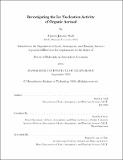| dc.contributor.advisor | Daniel J. Cziczo. | en_US |
| dc.contributor.author | Wolf, Martin Johann. | en_US |
| dc.contributor.other | Massachusetts Institute of Technology. Department of Earth, Atmospheric, and Planetary Sciences. | en_US |
| dc.date.accessioned | 2021-01-05T23:15:04Z | |
| dc.date.available | 2021-01-05T23:15:04Z | |
| dc.date.copyright | 2020 | en_US |
| dc.date.issued | 2020 | en_US |
| dc.identifier.uri | https://hdl.handle.net/1721.1/129044 | |
| dc.description | Thesis: Ph. D. in Atmospheric Chemistry, Massachusetts Institute of Technology, Department of Earth, Atmospheric, and Planetary Sciences, 2020 | en_US |
| dc.description | Cataloged from student-submitted PDF of thesis. Page 222 blank. | en_US |
| dc.description | Includes bibliographical references. | en_US |
| dc.description.abstract | Emissions of aerosol particles and their precursors affect climate directly by scattering radiation and indirectly by altering cloud properties. Aerosol-induced ice nucleation includes several processes that impact cloud formation, lifetime, albedo, and precipitation efficiency. Ice nucleating particles (INPs) promote ice formation at warmer temperatures and lower relative humidities than required to spontaneously freeze aqueous aerosol. This dissertation investigates the sources and ambient concentrations of organic INPs. We quantify the ice nucleation activity -- defined by the conditions required to initiate ice nucleation and the ice nucleation active site density -- of primary and secondary organic aerosol species. Organically-enriched sea spray aerosol emitted from bubble bursting mechanisms at the ocean surface are more effective INPs than inorganic sea salt aerosol. We demonstrate that polysaccharides and proteinaceous molecules likely determine the ice nucleation activity of sea spray aerosol. Our results illustrate that seawater biogeochemistry affects the organic content of sea spray aerosol and that enhanced primary productivity results in the emission of more effective INPs. We further investigate secondary organic aerosol (SOA) sources of INPs. Isoprene-derived SOA material is unlikely to significantly contribute to INP concentrations in the mid-latitude troposphere due to its poor ice nucleation activity. However, it may be an important source of INPs in convective outflow systems over forested environments. SOA material derived from hydrofluoroolefin refrigerant emissions is an effective INP, but our analyses predict it will not be abundant enough to impact cirrus cloud properties. These results demonstrate the diversity of organic INPs. By better understanding the sources, characteristics, and concentrations of organic ice nucleating particles, our understanding of aerosol-climate feedbacks will reciprocally grow. | en_US |
| dc.description.statementofresponsibility | by Martin Johann Wolf. | en_US |
| dc.format.extent | 222 pages | en_US |
| dc.language.iso | eng | en_US |
| dc.publisher | Massachusetts Institute of Technology | en_US |
| dc.rights | MIT theses may be protected by copyright. Please reuse MIT thesis content according to the MIT Libraries Permissions Policy, which is available through the URL provided. | en_US |
| dc.rights.uri | http://dspace.mit.edu/handle/1721.1/7582 | en_US |
| dc.subject | Earth, Atmospheric, and Planetary Sciences. | en_US |
| dc.title | Investigating the ice nucleation activity of organic aerosol | en_US |
| dc.type | Thesis | en_US |
| dc.description.degree | Ph. D. in Atmospheric Chemistry | en_US |
| dc.contributor.department | Massachusetts Institute of Technology. Department of Earth, Atmospheric, and Planetary Sciences | en_US |
| dc.identifier.oclc | 1227037173 | en_US |
| dc.description.collection | Ph.D.inAtmosphericChemistry Massachusetts Institute of Technology, Department of Earth, Atmospheric, and Planetary Sciences | en_US |
| dspace.imported | 2021-01-05T23:15:03Z | en_US |
| mit.thesis.degree | Doctoral | en_US |
| mit.thesis.department | EAPS | en_US |
